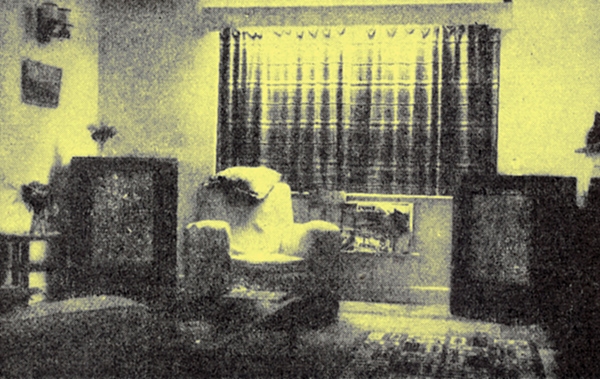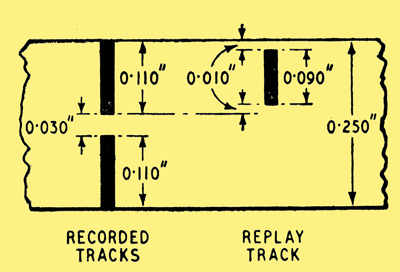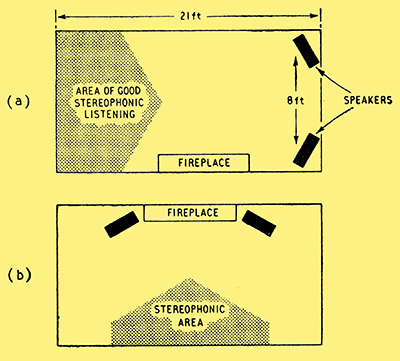|
An appreciation and some experiments in psycho-acoustics.

The author's living room (reverberation time 0.46 sec) showing placing of the loudspeakers for stereophonic sound reproduction.
In every key cinema in the country a stereophonic sound film system is now installed, and as the sound quality that can be obtained from a proper stereophonic recording is so impressive it is natural to apply similar techniques to domestic sound reproducer systems. The recently released musical film 'Oklahoma' is an excellent example of the results that can be obtained in the cinema from a stereophonic recording of music and singing.
The advantages of stereophonic sound reproduction are at least as great in the home as in a large hall, and the following notes are based on experience gained in running a two-channel stereo system in ordinary domestic surroundings. The views may be a little coloured by a professional interest in the design of stereo sound systems for cinemas.
It is not proposed to recapitulate the fundamentals of stereophonic sound reproduction, for this aspect has been adequately dealt with, but it will be remembered that two, three or five separate channels must exist between the recording studio and the reproducing room, the stereo performance improving as the number of channels is increased. Practical considerations restrict the number of channels to two when domestic equipment is considered.
Stereophonic recordings were made many years ago by Blumlein of EMI using simultaneous lateral and vertical modulation of a single groove on a gramophone record, but magnetic tape has so many advantages over discs that all current British releases are on twin-track magnetic tape. It seems likely that tape will become the standard storage medium though some of the smaller American companies issue a few discs having two recorded grooves.
In England the recordings available so far have been released on ¼ in magnetic tape by the EMI group under the HMV and Columbia labels and these are the only ones of which experience has been obtained. Without waiting for the end of the story it can be said at once that stereophonic reproduction in the home is a thrilling experience and one that results in a strong desire to 'ask for more'.
First a few words about the recorded tapes. The standard ¼ in tape provides space for only two tracks and a 30-mil space (approximately) between them to minimize crosstalk. The dimensions are as in Fig. 1.

Fig. 1. Track dimensions of EMl Stereosonic records.
A stereophonic recording demands that the two recording heads be in an agreed position and that the replay heads be in the same relative position. This is essential if the recording system is to preserve the time differences that are so important to a good stereo performance. EMI arrange their recording heads in line across the tape and it is thus essential that the replay equipment should also use heads with their replay gaps in line.
The microphone technique now employed in the EMI is based on the Blumlein proposals, two directional microphones being mounted one above the other and mutually at right angles. However, our present purpose is to discuss the results obtained under domestic conditions rather than the studio techniques.
Equipment Used
Commercial equipment for playing 'Stereosonic' tapes is available from several advertisers in Wireless World, but the price of a complete replay chain is a little on the high side for anybody on an engineers salary; in consequence the Writers equipment shows signs of cinematic connections! For the enthusiast willing to assemble his own equipment several firms have available tape decks, including two compensated pre-amplifiers with an output in the region of one Volt across 500 Ohms. At a still lower price a tape deck can be obtained and the pre-amplifiers and main amplifiers assembled at home.
The tape reproducer used in my experiments is a Ferrograph 2C/NF having in-line heads and an output of about one Volt from the two internal pre-amps. The main amplifiers are some standard units used in the smaller cinemas and having frequency characteristics within 1dB of each other over the whole audio-frequency range. Several types of loudspeakers have been tried, but it is still unfortunately true that the most expensive loudspeakers give the best reproduction. These particular examples are dual-channel, horn-through-the-centre-pole type (BTH Type K10A) mounted in ported cabinets. They can be seen in the accompanying photograph of the living room. If the room is large enough high-quality speakers of this type are ideal, but they are not essential, a point that will be referred to later. The seating, a settee and two easy chairs, was arranged across the room about 10-12 feet away from the speakers.
With this arrangement the results obtained are outstandingly good and represent a much greater improvement over long-playing records than the LP records show over the old 78 RPM recordings. The ordinary technical criteria, low harmonic distortion, wide frequency range, greater volume range, and low background noise, are inherently satisfied in a good magnetic tape recording and all the tapes tested set a standard much higher in these respects than any but laboratory examples of disc recording.
Surprisingly enough these characteristics received little comment from the 20-30 friends who have heard the results. What did receive comment from everybody, whether technically or non-technically minded, is the extraordinary improvement in clarity, the complete separation of orchestra and singers, the apparent size of the orchestra and the ease with which one can listen. This last point is a rather unsuspected and rather under-emphasized advantage of stereo recordings. One listening session ran into a couple of hours without the slightest sign of fatigue though the playing of a good LP record immediately brought the comment of 'How hard that is to listen to after hearing the tapes'.
Loudness Levels
The work of Somerville and Brownlees in England, and Chinn and Eisenberg in America has shown that the public have a marked preference for lower-than-original sound loudness levels when reproducing music at home. This has been confirmed on many occasions in the present house, peak levels greater than about 85 phon always raising adverse comment from the other members of the family. After ten minutes playing of the first stereo tape it became obvious that peak loudness levels well above 85 phon were being experienced, so the sound level meter was brought out. This confirmed that the peak levels were in the region of 95-98 phon, a loudness level that would certainly arouse protests if the standard monaural system was being played. Even when disaster was courted by a direct question 'What about the loudness?' only one listener in the group of six thought that 'it was a bit loud'.
A few words about some of the tapes that have been played 'The Marriage of Figaro' by the Glyndebourne Opera Company (HMV SAT 1007) is an outstanding example of the advantages of a stereophonic recording. Normally I have no special liking for opera sung in Italian, but this tape was played at least ten times during one day for the sheer pleasure of hearing the performance with all the spatial characteristics of the original. The orchestra is a separate group spaced from the singers, and the principal singers appear against the choral background without the least confusion. This is a recording to demonstrate to friends who believe they have a high-quality disc recording system.
Orchestral music is almost equally impressive, the Classical Symphony (Prokofiev, No. l in D Major) SDT 1750, being most satisfying both technically and musically. This was another recording that was replayed at least ten times during one week-end, always bringing all domestic activity to a standstill. A long experience of high fidelity at home suggests that continued satisfaction is a rarity if records are being played.
It must not be thought that a stereo system is only suitable for 'serious' music; Phil Green and his orchestra in 'Interlude for Melody', Columbia BTD 701, is another outstanding example of the advantages of stereo recording, though my eleven year old daughter informs me that Phil Green and his band are a 'square'. I am not sure what this means, but I suspect that he plays music rather than merely making a row. Perhaps somebody more attuned to the younger mind or having access to a suitable dictionary can translate the expression into English. A fair number of other recordings have been played, all with real delight, but those quoted might make a good foundation for a tape library.
Some twenty people have listened to the equipment at various times, most of them being high-quality enthusiasts though diluted by a wifely accompaniment. Without exception all their comment has been extremely favourable, but perhaps the greatest compliment is that three ladies sat for more than an hour listening to opera in Italian and music by Prokofiev and Sibelius without saying a single word to each other except in the intervals. In a very long experience of domestic high quality I have never known this happen when playing records. The explanation is probably fairly simple; the reproduction is so realistic that it would just be sheer bad manners to indulge in conversation.
Some of the more technical conclusions reached as a result of experiments are probably of interest. The loudspeakers used each have a fairly uniform polar distribution over an angle of about 60 degrees. Speakers having a less uniform angular distribution need to be placed more carefully but give very good results if this care is taken. The two ported cabinets were placed in the corners of the room, pointing down the length of the room and turned outwards to make an angle of about 30 degrees with the wall behind. The cone centres were then about 8 ft apart and the best listening position about 10-12 ft away. At greater distances the stereo effects existed over the whole floor area out to the end of the room 21 ft away. Listening positions closer to the loudspeakers than the speaker spacing lose a good deal of the stereo impression.
Several types of speaker have been tried and in general the better the individual speakers, the better the stereo result. However, the quality of the speaker and particularly the frequency range covered appear much less significant when using a stereo system. Any enthusiasts thinking of trying domestic stereophony need not be deterred by the absence of two speakers of top-class quality. When listening to a real orchestra the quality is not judged by the frequency range of the instruments, and the same attitude develops when using a stereo reproducing system. The frequency range that is reproduced seems much less important than the sense of size and spatial distribution produced by the system.
Loudspeaker Positions

Fig. 2. Alternative positions tried for the loudspeakers in a living room.
Speaker positioning is a bit of a problem if the best listening position is to be integrated with normal domestic activity and the viewing of television. Speakers placed across the end of the room as in Fig 2 (a) give very satisfactory results, but are generally difficult from other points of view. A speaker placed at each side of the fireplace as in Fig. 2 (b) has advantages, in that it faces listeners seated round the hearth but the heating system needs to be a little better than ' standard British' in order that the audience should be comfortable eight or ten feet from the fire. Seating positions outside the area demarcated by the speaker positions are not very satisfactory. The room used for the majority of the tests is fairly good acoustically (measured reverberation time 0.46 seconds at 500 Hz) but the acoustics of the listening room appear very much less important with a stereo reproducer system than with a monaural system. The acoustics of the recording studio are the predominating factor, a point well brought out when listening to the Glyndebourne recordings. Room size also appears to be a less significant factor, very good results being secured in a room only 12 ft x9 ft with the speakers across the end of the 9 ft wall.
One very important factor is the relative volume level from the two speakers. Any 2-channel stereo system must depend for its main effects on the intensity difference that is produced at the two ears, the intended result being secured by the correct positioning of the microphones at the recording studio. A reproducer system having separate gain controls in each channel allows the stereo result to be completely spoilt by incorrect setting of the gain controls. The ideal arrangement is undoubtably to have a single knob with the two channel controls ganged on the same spindle, though each channel must have a separate gain control that can be pre-set to equalize the acoustic output from the two channels. From this point of view it would be a great convenience to have available a 'balance tape' with short bursts of 1,000 Hz tone recorded alternately on each track. This would allow the acoustic outputs of the two speakers to be balanced and the gain control settings noted for future use. Such 'loudspeaker balance' films are available to the cinema engineer. (A loop of tape only 3 or 4 ft long is quite adequate.) The necessity of balancing, in some manner, cannot be too strongly emphasized, for lack of balance leaves the orchestra and all the singers on one side of the room, completely ruining any stereo effects.
The amplifiers used should have similar characteristics, a tolerance of ±1 dB over the frequency range being suggested. If variable tone controls are fitted these need to be set to give the same overall frequency characteristic, or the orchestra tends to be concentrated towards the loudspeaker having the best high-frequency response. Differences in frequency characteristic of more that 2 or 3 dB lead to a peculiar 'stretching' of the orchestra, while the individual instruments move about the stage as the player moves up and down the musical scale.
Finally about the future. In the cinema world stereophonic sound reproduction has been seriously jeopardized by the widespread release of films with identical sounds on all three tracks though advertised as having 'stereo-phonic sound'. In many films these have been dubbed on to the magnetic tracks from a single original photographic track. This is killing the goose with a vengeance. It is hoped that no one will attempt to foist such counterfeit on the domestic market.
In my opinion, stereophonic tape recordings of the present standard are sufficiently outstanding to ensure that they will be the accepted practice for all domestic high-quality systems in perhaps a couple of years time. Cost remains an obstacle at present, but it is to be hoped that prices will fall steeply as the demand rises.
|